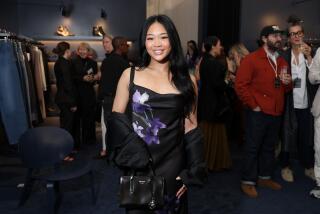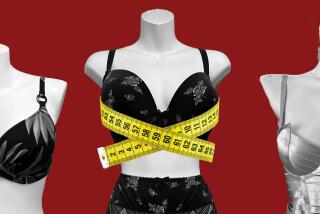Fashion 87 : Large Sizes Are Big Business and Still Growing
- Share via
Fact: Oprah Winfrey, one of daytime TV’s most talked-about stars, admits that her size varies greatly--from a Size 12 up.
Fact: The estimated 30 million to 40 million women in America who wear Size 16 or larger spent close to $8 billion on clothing in 1986. And fashion industry forecasters estimate that amount could triple in the next few years.
Fact: Lane Bryant, a chain catering to the large-size customer, was losing money in 1982 when it was acquired by the Limited Inc. After switching to a more updated styling concept, the chain opened 180 new stores in 1986. A company spokesman says there are plans to open 150 more this year.
Fact: At Bullock’s, the fastest growing area is the division that sells sophisticated large-size clothing at upscale prices.
Fact: In fiscal year 1986, the Forgotten Woman, a chain of 18 large-size boutiques, including one in Beverly Hills, reported sales of $17 million, up 42% over 1985.
Is somebody finally noticing?
Contrary to myth, large women don’t sit at home eating Haagen-Dazs or reading diet books. They work, entertain, play tennis, swim, get married, have babies and become the hostesses of big-time TV shows. And lots more. In other words, they lead full, fulfilling lives. And because they do, they buy clothes. Stylish clothes. And retailers’ cash registers are proving the point.
Yet despite a surge in the market, the woman who wears a Size 18 or larger has been hard-pressed to find career clothes, active sportswear, wedding dresses, maternity clothes and evening wear. The message at retail level is that women who wear big sizes are very different from smaller women. That their clothing needs are somehow more limited.
One Santa Monica consumer says she will drive 50 miles to West Covina Fashion Plaza “because it’s the only mall I know of that has a good selection of large-size fashions.” The mall includes Lady Miriam’s, Woman’s World, New Woman and Lane Bryant, all large-size clothing stores. “I went to Beverly Center and couldn’t find anything,” the same woman complained.
Retailers say it’s the manufacturers who aren’t responsive to larger women’s needs. Nancye Radmin, who opened the Forgotten Woman in New York in 1977, says she worked with five resources in the beginning. Now, 18 stores later, she works with 400.
“But even with that many suppliers, to get tennis clothes I had to
order a special cutting,” she says.
And manufacturers complain that retailers won’t take risks. “Nobody makes large-size maternity clothes because no stores are willing to take a chance,” states Michael Beattie, president of Gemini, a successful large-size dress company, whose sister firm, Libra, produces maternity clothes in standard sizes.
“Many retailers treat the large-size customer like a second-class citizen,” says Howard Meyers, national sales manager for Sue Wong, a firm that produces standard and large sizes. “One store in Philadelphia stuck the large sizes between children’s wear and crystal--the worst location in the store. How is the customer supposed to feel?”
Hana Estroff Marano, the fashion director of Fashion Plus, a large-size editorial and advertising supplement that appears in such magazines as Family Circle and Vogue, observes that most manufacturers and retailers fail to listen to the consumer.
After analyzing the survey responses of 3,500 large-size readers, Marano says these women “are extraordinarily conscious of quality and generally unsatisfied with the quality available to them. Poor quality and poor design, they tell us, is another way of making these women feel like second-class citizens.”
For many years, stores that carried large sizes overlooked quality in favor of keeping prices low--another myth being that large-size customers would not invest as much in clothing as other shoppers.
“We didn’t get poor because we got fat or vice versa,” retorts Carole Shaw, editor of Big Beautiful Woman (BBW), a magazine aimed at women who wear Size 14 and above.
“Until recently there just weren’t quality clothes available to us. The money has always been there; it’s just there waiting to be spent.” Retailers who opted to develop their large-size departments are seeing that money being spent.
Aware manufacturers have ventured into large-size garments never explored in years past: lingerie, leotards, jogging suits, belts, authenic Levi’s 501 jeans, even full-length furs.
At I. Magnin, large-size dress buyer Cathy Waxman says her best-selling item last fall was a green silk chemise for $198, followed by a red silk at $130. She states that her customer will spend $100 to $160 for a “basic work dress,” about $400 for evening wear and $150 to $225 for a silk daytime dress, “as long as the quality is there,” she stipulates.
Marano says fit was another area of complaint from the Fashion Plus survey respondents. “The whole market produces merchandise that fits one large-size body type. We got an enormous response from women who are taller or shorter than the average--they aren’t being served.”
One of the big changes at Lane Bryant after the Limited Inc. took over was the standardization of sizes.
“In the past, a woman had to buy a Size 16 1/2 dress, a Size 32 skirt and a Size 36 blouse. Now she just has to look for a Size 18 in everything. It’s simpler,” says Susie Phillips, vice president of marketing.
I. Magnin’s Waxman notes that it’s important for large-size customers to realize that a 14 regular and a 14 large-size are completely distinct from each other.
“A large Size 14 is comparable to a Size 18 in missy sizes. That can be confusing and discouraging for many shoppers,” she points out.
Waxman says she meets price resistance from only one segment of her clientele: those who are planning to lose weight.
“They’re faced with a dilemma. They don’t know whether to spend the money on a garment that looks good now or buy something less expensive now and get the better dress two sizes later. But I’m finding that more and more of my customers accept themselves the way they are right now.”
“Large-size is not a temporary buy,” says Ilse Metchek, owner of Plush by Ilse M, a career dress collection in Sizes 14-24. “She’s not constantly struggling to lose weight all the time anymore--she wants to look good now. Most stores haven’t awakened to her needs.”
“The large-size woman is the most responsive customer in the store,” says Gail Conway, buying supervisor for large sizes at Bullock’s. “She comes to fashion shows, asks questions, calls and makes special requests. She’s learned to make her needs known. She has all the same needs to feel wonderful as a petite or any other woman. She just hasn’t had a means of meeting those needs until a few years ago. Hers were always the clothes relegated to the basement and the inexpensive, low-end departments.”
The Bullock’s Woman department in the Costa Mesa store occupies 5,000 square feet of space, making it one of the largest large-size departments on the West Coast.
“Our research shows that this customer is a working woman, aged 35-45, who wants career clothes,” explains Marc Ware, divisional merchandise manager for special sizes at Bullock’s.
“We emphasize upper-moderate to better merchandise, and we’ve found that our customer is willing to pay higher prices than her missy counterparts if the quality and design are there.”
Ware notes that his large-size departments are experiencing double-digit sales volume increases.
Despite the industry estimates that 50% of the adult female population wears a Size 12 or larger, that 30% wears Size 16 or larger, and that another 30% to 35% wear petite sizes, most fashion designers and fashion magazines still push the 5-foot, 9-inch, Size-6 or -8 ideal, thus addressing less than one-third of the women in America.
Pat Swift, a former large-size model turned modeling agency owner, says there’s hope. She started her business in 1977, representing a handful of large-size models. Today her agency handles 60 Size 12, 14 and 16 models.
She cites models on her roster, such as Denise Patrick, who commands $1,200 a day for lingerie and bathing suit work.
Most large-size models are a “well-proportioned Size 14,” Swift says, a figure that seems like a fantasy to many large-size consumers.
“Models are meant to make the clothes look their best. We’ve come a long way from the days when large-size stores showed their clothes on Size-8 girls.”
Sue Wong’s Meyers says many designers won’t work in large sizes “because they think their work will be distorted. They don’t realize that a properly fitting garment looks good on all women.”
“When we asked large-size women what their favorite designer labels were, some responded to large-size manufacturers. But the overwhelming favorites were Anne Klein and Calvin Klein, neither of whom makes large sizes,” Marano explains.
At More Jazz, a large-size collection that developed from All That Jazz, a junior line, division head Stan Levine says his customer is “so hungry for fashion styling that we are constantly looking for new ways to please her.”
“For so long, large-size women felt trapped into thinking that they had to wear black and dark colors instead of wearing colors that make them feel happy,” says Amy Greenberg, vice president of marketing for the Richard Simmons Clothing Co., another rapidly growing firm that specializes in large sizes.
“The message that we are trying to get across is that large-size women can wear anything they want, as long as it fits.”
More to Read
Inside the business of entertainment
The Wide Shot brings you news, analysis and insights on everything from streaming wars to production — and what it all means for the future.
You may occasionally receive promotional content from the Los Angeles Times.










